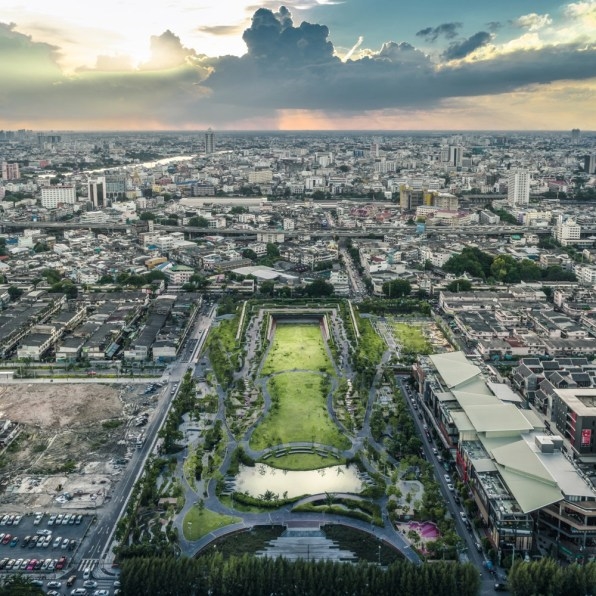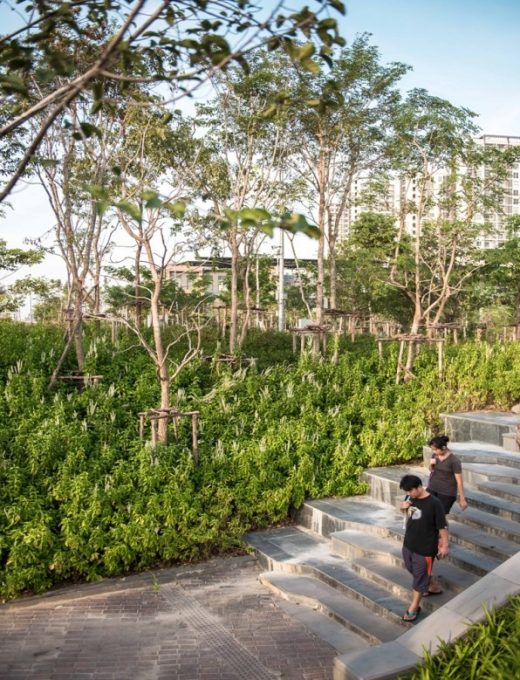This new park is designed for a future of flooded cities
Sitting on former swampland in a low-lying river delta, Bangkok has always flooded. In the 1800s, the majority of the population lived in floating homes and a Venice-like network of canals served as major streets; some of the land was used for farming. But as the area has grown into a sprawling megacity, canals have been filled to make way for development. Rice paddies and fruit plantations have been paved over. As there’s less room for water to go, floods have gotten worse. The problem is compounded by the fact that the city is slowly sinking, while sea levels rise. Climate change also makes heavy storms more common.
At the center of the city, a new park is designed to help with flooding: In a major storm, the 11-acre park can hold nearly 1 million gallons of rainwater. “It floods in the rain garden rather than on the street,” says Kotchakorn Voraakhom, a landscape architect and founder of the urban design firm Landprocess, who designed the park for Chulalongkorn University, the city’s oldest university. Voraakhom is also a TED fellow.

The park, called Chulalongkorn Centennial Park, slopes gently upward, creating a small hill in the otherwise flat city. Built on land owned by the university, the park is part of a plan to revitalize this area of central Bangkok. At the highest end, a museum is topped with a large green roof covered with native plants. When it rains, water filters down into three large storage tanks under the museum; in the dry season, the water can be used to irrigate the park. Rain also flows down through four wetlands in the park, where a series of plant-filled ponds help filter the water. At the lowest point in the park, water ends up in a small retention pond.
When rainfall is light, the retention pond can contain all of the water. But in a heavier storm, the water can expand upward into the main lawn of the park. Next to the museum, the slightly concave lawn can hold more than 100,000 gallons of water. “This infrastructure is not about getting rid of flooding,” says Voraakhom. “It’s about living with flooding.”

When the rest of the city floods–overwhelming the sewer system–the park can continue to hold the water. At the retention pond, a couple of stationary bicycles sit next to the water; as people ride for exercise, the bikes turn small wheels in the water, helping add oxygen to prevent the growth of algae.
For people living in Bangkok, the park offers green space in a city that’s mostly concrete. Bangkok has only 3.3 square meters of green space per resident, versus 66 square meters per person in Singapore, or 23.1 square meters per New Yorker. “The surroundings of the park will become high-rises and many other developments in the future,” says Voraakhom. “But at least we have the opportunity to really open up this big concrete surface of the city to be a green public space.” Like other parks, it helps offset the urban heat island effect–the fact that paved-over cities suffer more in heat waves. On the busy street next to the park, some of the road space has become a bike lane and sidewalk. But the most critical function is the park’s ability to deal with floods that will become more frequent as climate change exacerbates both droughts and extreme rainfall in the area.
It’s a shift from Bangkok’s usual thinking about parks. “It’s not so much about decoration,” says Voraakhom. “It’s about infrastructure that we need.” The city also needs other infrastructure. Voraakhom believes that the city should also restore some of the former canals. Bangkok plans to improve its system of drains, which are both inadequate and deluged with plastic trash. But it may need more land to absorb water directly, making up for the plantations and wetlands that have been replaced by condos and roads.
As people experience the park, which was completed in 2017, Voraakhom believes that it will help build more support for similar green space throughout the city. Her firm recently completed another green roof on top of a local hospital, and a park for another local university (more than three times larger, at 36 acres) will be completed in 2019.
She also founded Porous City Network, a social enterprise that is helping train young landscape architects to help climate-threatened cities throughout Southeast Asia become more resilient. She has been inspired by the Netherlands–another low-lying country, with designs like a public square and parking garage also designed to flood in storms–but also recognizes that Thailand and other developing countries don’t have the budget to address flooding in some of the ways that the Dutch have, such as a massive seawall. Patterns of rainfall and drought, along with sinking land, also vary depending on location, and designers will need to create local solutions. “There are patterns of climate change that I think each country needs to understand,” she says. “You can’t just buy technology and install it.”
Fast Company , Read Full Story
(54)


